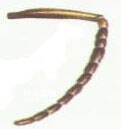Except for Protocera, which has no antennae, and higher Diptera and Hymenoptera larvae, which have degenerated antennae, all other species of insects have one pair of antennae. The tentacles grow in the middle and upper part of the insect's two compound eyes. When the insect is active, these two tentacles are always swinging, looking east and west, like a radar looking for prey.

The antennae are the main sensory organs and have the functions of smell, touch and hearing. Antennas help insects find food and mates, and detect obstacles in front of their bodies. In some insects, the antennae also have other uses. For example, the male coriander is used to hold the female during mating, the larvae of the devil mosquito are used to capture food, the antennae of the backstroke stink bug can balance the body in the water, and the terrapin is used to help breathe.
The antennae are grown in two small pits called antennal fossae on the front of the head. The tentacles are usually composed of many small segments, which can basically be divided into three major segments. The section near the antennal fossa is usually short and thick, supporting the above sections. It is equivalent to the handle of the leaf and is called the stalk node. The second section is smaller and is called the stem section. The third major section is called the whip section, which is the entire section after the second section and is usually divided into many sub-sections. The whip segments vary greatly among various types of insects, forming different types. Knowing the type of antennae can be used to identify insects. In some insects, male and female antennae are different, such as some moths. The tentacles mainly fall into the following categories (partly imitating the colorful Wanzhi pictures):

(1) Linear (filamentous): The antennae are slender and cylindrical. Except for the first and second segments, which are slightly larger, the remaining segments are similar in size and shape and gradually taper toward the end. For example, locusts, crickets and some moths.

(2) Bead-shaped: The whip section is composed of approximately bead-shaped sections, all of the same size, like a string of beads. For example, termites, brown flies, etc.

(3) Serrated: The end corner of each sub-section of the whip section protrudes to one side, like a saw blade. For example, the kowtow bug, female mung bean weevil, etc.

(4) Ctenoid shape: Each subsegment of the whip section protrudes very long to one side, shaped like a comb. For example, male mung bean Elephants-Are-Endangered.html">elephants, etc.

(5) Double dentate (pinnate): Each subsegment of the whip segment protrudes to both sides into a twig-like shape, much like a bird's feathers. For example, male silkworm moths, poisonous moths, etc.

(6) Rod-shaped (club-shaped): The antennae are slender, and the proximal segments are enlarged like an elliptical sphere. For example, butterflies (one of the main distinguishing features between butterflies and moths in Lepidoptera), ant flies, etc.

(7) Hammer-shaped: Several segments at the end of the whip joint suddenly expand, shaped like a hammer. For example, ladybugs, cockroaches, etc.

(8) Gill lobes: The end segments expand into flakes and can be opened and closed, resembling fish gills. This kind of antenna is unique to the Coleoptera scarabs.

(9) Knee-shaped (elbow-shaped): The stalk section is particularly long, the stalk section is short, and the whip section is composed of sub-segments of similar size, and is bent like an elbow or a knee between the stalk section and the stalk section. Such as weevils, bees, wasps, etc.

(10) Ring-shaped: Except for the two sections at the base, each section has a ring of fine hairs, and the hairs near the base are longer. Examples include male mosquitoes, chironomids, etc.

(11) Setalike: The antennae are very short, the first and second segments at the base are larger, and the remaining segments suddenly shrink and are as thin as bristles. For example, dragonflies, cicadas, plant lice, etc.

(12) With awns: The antennae are very short, and the flagellum has only one segment, which is thicker than the handle and peduncle. There is a bristly or awn-like structure on it, which is called the antennal awn. Some of the antennal awns are smooth, some are hairy or feathery. This type of antennae is unique to flies of the order Diptera.
animal tags: insect antenna shape organ radar
We created this article in conjunction with AI technology, then made sure it was fact-checked and edited by a Animals Top editor.